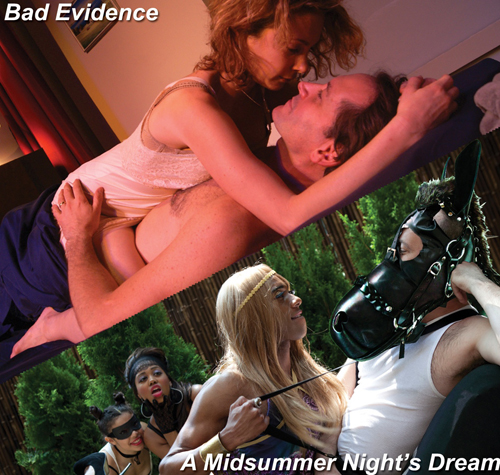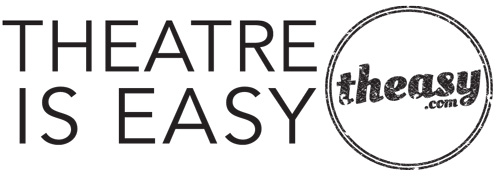FEATURED ARTIST
JULY 2011
The Hive and the cell
A Theasy Interview with The Hive's Artistic Director and co-founder, Matthew A.J. Gregory, the cell's Artistic Director, Kira Simring, and the cell's Founding Artistic Director, Nancy Manocherian
This summer, The Hive and the cell join forces to present “The Summer of Lust,” which includes A Midsummer Night’s Dream and Bad Evidence playing in rep through July. The bill might encompass one old play and one new play, but both fit under the subhead “smoldering portraits of contemporary relationships.” Insert sexy cat noise here.
We sent some questions to The Hive’s Artistic Director and co-founder, Matthew A.J. Gregory (who is also directing Midsummer), to the cell’s Artistic Director, Kira Simring (who is also directing Bad Evidence), and to the cell’s Founding Artistic Director, Nancy Manocherian, to learn more about the joint endeavor. Here’s what they had to say.
 THEASY: What are your missions? What are your companies all about?
THEASY: What are your missions? What are your companies all about?
NANCY: the cell’s mission is to incubate and present new works of art. We are an artist run arts organization dedicated to creating opportunities for artists in all disciplines by providing a nurturing space for individual and collaborative work among the many diverse artists who work in our space.
MATT: The Hive’s mission is about breaking down the traditional theatre hierarchy and empowering all of the artists involved to collaborate on a level playing field. We aren’t at all top down as a company. It’s truly a collective, where actors feel free to make suggestions and to work with set designers on scenery, and a lighting designer can feel comfortable in making a suggestion to an actor about a moment they are playing on stage. While many of our members fall into traditional disciplines, there aren’t the kind of rigid boundaries between roles as there often is in other theatrical endeavors. The Hive firmly believes that if we get the right artists in a room together, someone involved will have the creative solution to any problem that comes along. It is the second half of our mission, “building and serving the community through play,” that I think makes the Hive unique however. We believe in play in every sense of the word, and we are all about our community. We don’t just produce plays, we also host bar nights of drinking and merriment, themed one-night events, and a variety of other programming that falls outside of traditional theatre. Play is the unifying factor in all that we do, for audiences and for ourselves. We want audiences and artists alike to use plays and play as a way to grow into an ever enlarging community.
THEASY: How long have your organizations been around? How did they begin?
NANCY: the cell been around five years and has had the current space for three years.
MATT: The Hive just celebrated its first year in existence in March 2011. The Hive was actually born at the cell. About two years ago at the cell, I directed and co-adapted a modern reinterpretation of Moliere’s The Hypochondriac, which exposed the ills of America’s pill-pushing, dysfunctional health care system. Many of the members of the Hive were the cast, crew and designers in that show. We all had an extraordinary experience working together on The Hypochondriac. We found ourselves in a uniquely joyful and ego-free experience where everyone involved were able to contribute to creating a fantastic show. That production garnered fantastic reviews, and since [then], other theatres and schools have expressed interest in producing the adaptation we all crafted. In fact, a high school in Colorado did our adaptation in May, and we couldn’t be happier that the work is inspiring communities elsewhere in the U.S. Quite simply, everyone involved in The Hypochondriac wanted to continue to play and expand our community of artists and audiences. So far, it’s been a wild and exciting ride!
NANCY: the cell welcomes innovative theater, such as the Hive has brought to the cell. We hope their residency with us will lead them to even greater horizons to which their company aspires.
THEASY: This summer you’re presenting A Midsummer Night’s Dream in rep with Bad Evidence. We’re probably all pretty familiar with Midsummer, but what is Bad Evidence about?
KIRA: Bad Evidence centers around a married couple struggling with the essential closeness and isolation of marriage. A truth-telling session explodes first in their bedroom and then in their social circle.
THEASY: Since the productions are together titled “A Summer of Lust,” can you elaborate on how the shows complement each other under this theme?
KIRA: Both shows deal with the themes of marriage and power. In Bad Evidence, imploding marriages lead to exploding secrets. In our production of Midsummer, secrets lead to an explosion [of] conventional values.
NANCY: We are truly dedicated to presenting new works and new takes on traditional works. We believe the two shows together will yield some interesting discussions!
THEASY: Your Midsummer offers Hermia and Lysander as lesbian lovers and Demetrius and Helena as a gay couple. Was the initial goal to look at sexual orientation through Shakespeare, or was it to use Midsummer to provoke something socially relevant? In other words, what came first, the desire to do this piece or the angle with which to look at the characters and their relationships?
KIRA: Nancy’s idea was to create “Shakespeare in the Rear” which was the inspiration for the choice to do a new take on a classic.
MATT: The old chicken and the egg question…well, to be completely honest we decided to do Midsummer before any concept was discussed and I didn’t want to direct it. [I wasn’t interested] in directing yet another iteration of the ubiquitous Midsummer everyone has come to expect. I didn’t want to direct a fluffy comedy with cute fairies in butterfly wings. I just felt like Midsummer had been done too often and was so steeped in cliché that I didn’t want to go anywhere near it. The Hive, however, is a collective and the group wanted to do the play this summer at the cell, and they wanted me to direct. So, I re-read the play and it all became clear: Midsummer’s central conflict revolves around choice in marriage and if we were going to produce Midsummer in Chelsea in this day and age then the play’s social relevance had to be through the lens of same-sex marriage. Marriage equality is very important to our community, and it is a very important civil rights issue in the modern day. We couldn’t be more excited that the Marriage Equality Act is now law in New York, and it is such a privilege to be performing this unique take on Midsummer in the wake of that landmark legislation.
THEASY: What excites you most about your July productions?
KIRA: For both the cell and the Hive this is an ambitious undertaking – [two] full productions in tandem. We’re excited to grow and flex our artistic muscle. Both shows are innovative and somewhat daring – just the way we like things!
MATT: I can’t wait for [the] audience to come see and hear a Midsummer that defies all of the usual expectations. Our Midsummer will shed a whole new light on a play that everyone thinks they know, and I know that audiences will have their thoughts provoked and funny bones tickled by this production. I am also so excited to be exposing Terry Quinn’s new play, Bad Evidence, to the NYC community. He is a major talent, and I know audiences will be blown away by Terry’s fantastic exploration of modern marriage.
THEASY: Why should audiences check out “A Summer of Lust?”
KIRA: It is theatre at its best at an affordable price in a beautiful, unique Manhattan setting.
MATT: Why check it out? If you like sex, lust, comedy and great theatre, then you would be crazy not to check it out. If you don’t like those things, we don’t have much for you.
THEASY: What are your overall objectives in the coming years?
NANCY: To fulfill our mission of incubating and presenting new works.
MATT: The Hive was very pleased to become a Resident Company at the cell this year, and we hope to continue to produce exciting new plays and reinterpretations of the classics with our sponsors at the cell in the coming years. This coming fall, we have plans to co-produce a new play with the cell that was discovered through our Hive Exposed Reading Series titled An American Family Takes a Lover, by Amina Henry. It will be directed by the cell’s Kira Simring. Amina’s provocative play is going to stir up audiences and get them seeing race in modern America in a very different way. The Hive also plans to begin work on a devised piece based on the life and writings of Wilhelm Reich, as well as our second year of the Hive Exposed Series; staged readings of plays by new and underexposed playwrights.
